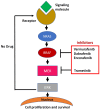The Power of Fish Models to Elucidate Skin Cancer Pathogenesis and Impact the Discovery of New Therapeutic Opportunities
- PMID: 30544544
- PMCID: PMC6321611
- DOI: 10.3390/ijms19123929
The Power of Fish Models to Elucidate Skin Cancer Pathogenesis and Impact the Discovery of New Therapeutic Opportunities
Abstract
Animal models play important roles in investigating the pathobiology of cancer, identifying relevant pathways, and developing novel therapeutic tools. Despite rapid progress in the understanding of disease mechanisms and technological advancement in drug discovery, negative trial outcomes are the most frequent incidences during a Phase III trial. Skin cancer is a potential life-threatening disease in humans and might be medically futile when tumors metastasize. This explains the low success rate of melanoma therapy amongst other malignancies. In the past decades, a number of skin cancer models in fish that showed a parallel development to the disease in humans have provided important insights into the fundamental biology of skin cancer and future treatment methods. With the diversity and breadth of advanced molecular genetic tools available in fish biology, fish skin cancer models will continue to be refined and expanded to keep pace with the rapid development of skin cancer research. This review begins with a brief introduction of molecular characteristics of skin cancers, followed by an overview of teleost models that have been used in the last decades in melanoma research. Next, we will detail the importance of the zebrafish (Danio rerio) animal model and other emerging fish models including platyfish (Xiphophorus sp.), and medaka (Oryzias latipes) in future cutaneous malignancy studies. The last part of this review provides the recent development and genome editing applications of skin cancer models in zebrafish and the progress in small molecule screening.
Keywords: medaka; molecule screening; skin cancer models; zebrafish.
Conflict of interest statement
The authors declare no conflict of interest.
Figures

References
-
- Key Statistics for Melanoma Skin Cancer. American Cancer Society; Atlanta, GA, USA: 2018.
Publication types
MeSH terms
LinkOut - more resources
Full Text Sources
Medical
Miscellaneous

